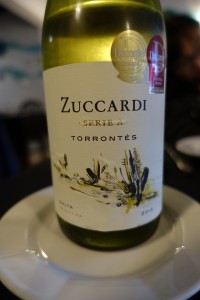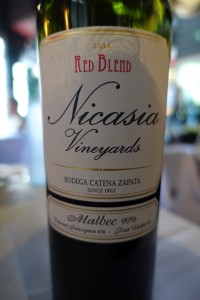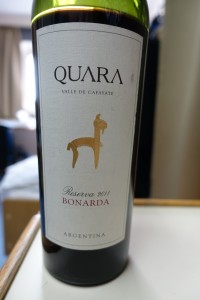Malbec is one of my least favorite varieties. However, I spent most of December in Argentina and Antarctica, and you know what that means: My Month of Malbec.
It’s daunting to spend a month in a country where you dislike what everyone else drinks, and in Argentina, Malbec is more popular than sunny weather. A guy saw me drinking Torrontés with king crab in Ushuaia and asked why on earth would I would have white wine when the restaurant sells red. I offered him a taste with his crab, but he declined, satisfied with Malbec.

- Though you don’t see many locals ordering them, Argentine white wines are really underrated, especially cheap ones. A $3 Torrontés (Etchart Privado) from a grocery store was one of my favorite wines. Unfortunately, you can buy that in grocery stores in Belgium but not in the U.S. I also had a delightful Bodegas Lopez Semillon at $3 for 375 ml in a restaurant. You can’t buy that here either. Sigh. The producers don’t trust North Americans with these whites, instead sending us Chardonnay because that’s the grape U.S. consumers know.

- When I say “underrated,” I mean it literally. Decanter gave a World Wine Award to Zuccardi Serie A Torrontés. Wine Spectator hung an 84 on it, about what they give fermented pickle juice. In Argentina, Wine Spectator is a malevolent force, rewarding wines with 200% new oak (They take the wine out of one new oak barrel and put it in another! Really!) and punishing wines that taste like the grape variety.
- This leads to words being defined differently than you expect. “I like more old-world style wines,” I told a restaurateur. “Classic,” he said. I nodded. “We have classic wines,” he said. “That Malbec, very classic, it got 94 points from Robert Parker. Very strong, lots of oak. That one is also classic, very good oak flavor.”
- Wine counterculture is tiny, but does exist. At two good restaurants in Buenos Aires we found idiosyncrasies like unfiltered Ji Ji Ji Chenin Blanc (terrific) and carbonic maceration Revolucionaria Bonarda Pura that tastes like cru Beaujolais (one of my favorite wines in the country, and available in the U.S. under $20). We never saw wines like these in shops, though: “sommelier wines” haven’t hit retail.
 Instead, you choose from the same dozen producers over and over. At the end my favorite was Catena. Their wines are expensive, but we had several refreshing, balanced Malbec-based red blends and a nice barrel-fermented Chardonnay. I also had one of the best grappas I’ve ever had from Catena, made from Malbec. This grappa was the one bottle I searched for at the end of the trip, but I never found it.
Instead, you choose from the same dozen producers over and over. At the end my favorite was Catena. Their wines are expensive, but we had several refreshing, balanced Malbec-based red blends and a nice barrel-fermented Chardonnay. I also had one of the best grappas I’ve ever had from Catena, made from Malbec. This grappa was the one bottle I searched for at the end of the trip, but I never found it.- Similarly, the total number of grape varieties in Argentina is very limited compared to other bigtime wine countries, and make no mistake, Argentina is one: people drink more wine per capita than Spain, and more than twice as much as the U.S. You see a lot of Bordeaux red varieties, Pinot Noir, Sauvignon Blanc, Chardonnay and Torrontés, and anything else is a rarity. We had a good Riesling, but only saw one. You don’t generally see Italian or Spanish or Portuguese varieties.
- People in the wine trade are not aware that there’s a debate about alcohol percentage. Several times folks told me, “They’re all the same,” when I asked about alcohol, even though they’re not: we had red wines as low as 13.3% alcohol and saw them as high as 15.5%. Even good sommeliers were not prepared if asked for a lower-alcohol wine and had to get the bottles and check.
- For all the exotic implications of Patagonia, its vineyards are not much cooler than those of Mendoza. There are no true cool-climate vineyards in Argentina, apparently. But Bodega del Fin del Mundo (End of the World Winery) markets the heck out of itself in Ushuaia to tourists on their way to and from Antarctica. Argentina has high-elevation vineyards like nowhere else, but it’s all warmer than it looks on the winter photos.
-

Not even furry animals can move Bonarda. Bonarda is the second-most planted grape in Argentina, but it’s disrespected by sommeliers (one told me about the only Bonarda on her list, “I’m trying to take it off”) and most goes unnamed in red blends. Some of my favorite wines were Bonardas, and when I brought wines on our ship to Antarctica, the Bonardas were the biggest hits with our new friends who aren’t wine connoisseurs. It’s a fruity, low-tannin, easy drinking red wine, and I think the trade gets in the way of its popularity, because ordinary consumers like it.
- Torrontés has the same problem. Argentines in the trade don’t respect their local varieties. Some 100% Torronti are billed simply as “white,” and Torrontés doesn’t fetch the prices of Chardonnay or Sauvignon Blanc.
- Malbec gets way more expensive than I realized. Super-high-end Malbecs are available in the U.S., but I never see them. Buenos Aires steakhouses have a lot of Malbecs over $100 U.S., a surprising number over $400 U.S. and some over $1000 U.S. This is the same price range as California Cabernet, but with Malbec, we’re talking about a wine that became popular because it delivers big fruit at a low price. However, when people go to nice restaurants in Buenos Aires, some are looking to splurge and Malbec is there for them.

- Cabernet Sauvignon is a very distant second as a high-end restaurant wine. My favorite steakhouse wines were blends of Cab and Malbec.
- I never learned to love Malbec, but one can drink any country’s wines for a month quite happily. Bring it, Bulgaria.

